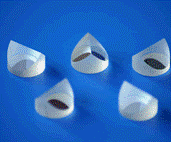What is a pyramid prism? The pyramid prism, also known as the Paul prism, is an optical element used in optical instruments and is a refractive triangular prism used to modify the orientation of images.
A pyramid prism is an isosceles right angle prism formed from glass, with the end plane facing the right angle. In use, light enters from the large rectangular surface of the prism, undergoes two total reflections on the inclined surface, and then exits through the original incident plane. Because light only enters and exits in a normal state, the prism does not have the effect of dispersion. However, the image passing through the pyramid prism will be flipped 180 ° and enter in the original direction, that is, the pyramid prism.
The direction in which the pyramid prism enters has also changed by 180 °, but because the image undergoes two reflections, the partial chirality does not change. Pyramid prisms are typically used in pairs in a combination of bipyramid prisms, with the second prism rotated 90 degrees relative to the previous one. “The net effect of the prism system is that the incident light is changed in the direction of travel in parallel, and the image is rotated 180 degrees, leaving the chirality unchanged.”.
The bipyramid prism system is suitable for small optical telescopes to change the image direction (arrangement of image reconstruction systems), especially in many binoculars to provide image reconstruction and longer optical path folding, effectively shortening the distance between the objective lens and eyepiece. Typically, in a combination of bipyramid prisms, the two prisms are glued together and the excess parts are cut to reduce warp weight and size. A single Paul prism can also be considered a roof prism, but it is not used in binoculars. A variant of the double Paul prism is the Paul Abbe prism.




